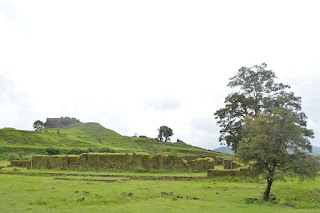The 15th century Shivappa Nayak fort, built by one of the greatest rulers of this region is a tourist spot near Shimoga but unfortunately it is in a dilapidated condition due to poor upkeep. Quite amazing are its size, moat around the fort and bathing water tanks with separate entry. Visitors to the fort will be impressed by the monsoon or post monsoon growth of lush greenery and serene surrounding places including the sight of small hills.
 |
| Shivappa nayaka's fort, Nagar, KA youtube.com |
Once called Bidarahalli it gained historical importance during the reign of Hiriya Venkatappa Nayaka (1592-1629 AD) of Ikkeri kingdom. it was elevated to the status of capital from the time of Virabhadra Nayaka (1629-1645 AD) who succeeded Hiriya Venkatappa Nayaka.
 |
| ruler Shivappa Nayaka, Nagar indiathedestiny.com |
Above image: Shivappa Nayaka (r.1645–1660), was a popular ruler in South India during the 17th century AD. .Known as Keladi Shivappa Nayaka, he ruled the Keladi Nayaka Kingdom from 1645 to 1660 AD diligently. Generally, the Keladi Nayakas belonged to Veerashaiva Lingayath Community, They were successors of the Vijayanagara Empire in the coastal and Malnad (hill) districts of Karnataka, India, in the late 16th century. Shivappa introduced ingenious tax systems which were called Sist. According to the tax system, the agriculture lands divided into five types and tax was levied based on the type. He provided the water irrigation system. A brave and dashing warrior, he raided the Bijapur Sultanate and captured the modern Dharwad District. He also invaded Srirangapatnam and became a forve to reckon with in South Karnataka. He captured all Portuguese Coastal territories and eliminated their dominance in Karnataka and Kerala. A keen observer of the Hindu Vedic rituals he gave preference to the Hindu Advaita theory propounded by Adi Shankara Charya of Kalady, Kerala. . He gave preference to Vedic sacrifices and orthodox rituals. Being secular, he gave he respected other religions..(https://indiathedestiny.com/indian-kings/shivappa-nayaka)...............................
 |
| Shivappa nayaka's fort, Nagar, tripoto.com |
The nayak rulers consistently faced threats from near-by Bijapur sultanate. lkkeri was reduced to rubble in 1560 during the unexpected raid by Islamic forces under Ranadulla Khan of Bijapur Sultanate though Virabhadra Nayaka’s fought valiently to repel the invading army. Consequently Ikkeri became a hot bed of political and economic domination between rulers and finally Virabhadra Nayaka abandoned it.
Giving utmost importance to defense and security to retard further invasion from Muslim rulers ruler Virabhadra Nayaka had built a strong and sturdy fort at a strategic place - Bidnur with beautiful palaces and made it his new capital in 1639 AD. Sivappa Nayaka (1645-¬1665 AD) who ascended the throne after his father became an active ruler, gained administrative skills and enlarged it his kingdom. His successor ruled from here till it was seized by Hyder Ali in 1763 AD. He renamed Bidnur as Haider Nagar and now it is called as Nagar only. During his reign he established the mints here and Haideri gold pagodas were struck here. During the Angelo- Mysore War it suffered badly due to burning. Tipu Sultan rebuilt the palace and its surroundings. However, it never regained its lost glory and slowly it was abandoned to its present condition
The stone masonry ifort is in almost ovoid on plan with a series of bastions at regular intervals. Constructed above the masonry wall is the thick parapet with a series of musket holes. Surprisingly, many guard rooms are provided in the interior wall for the convenience of security guards. adjacent to the exterior fort wall is a deep moat with retaining walls running around. Access to the fort is through a steep ramp leading to the main entrance from the north. There are bastions on either side of the gateway.
Inside the fort one can see tank to the west and remnants of the palace to the south-east. The tank is built with many compartments and entrances with a flight of steps. The palace building in rectangular plan is at a higher level and has a series of rooms and halls. The large open area to the west seems to have been used to accommodate audience. At the south west corner is a deep octagonal well. there is an observatory tower which can be accessed through a steep ramp at the extreme end of the open courtyard abutting the outer fort wall.
In the SW corner of the fort there is a deep octagonal well and the depression further south of the octagonal seems to be a storage tank to the south east of which is a huge mound probably enclosing a huge rubble structure.
Many structural parts of the fort are in ruins and scattered here and there, but, amazing thing is they represent careful planning of the post medieval layout of fort.
Nagar ( earlier known as Bidnur or Venupura) is about 16 km from Hosanagara town and is about 85 km from Shimoga town of Karnataka.
http://asibengalurucircle.in/shivappa-naiks-fort-nagar
https://indiapl.com/karnataka/shivappa-nayaka-fort-559921









